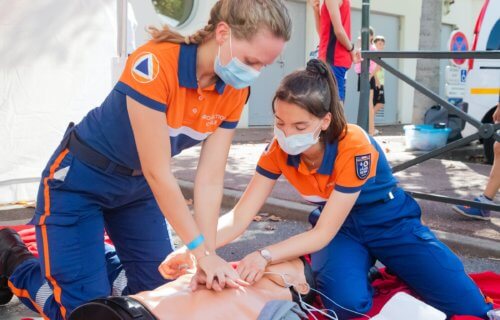MILAN, Italy — Cardiopulmonary resuscitation (CPR) can save lives, but the coronavirus pandemic has made it a much more complicated procedure. While some emergency workers are learning to perform CPR without mouth-to-mouth or while using a breathing bag, a new study finds you can actually give someone mouth-to-mouth while wearing a face mask and it will still be effective.
Researchers at the annual meeting of the European Society of Anaesthesiology and Intensive Care (ESAIC) say mouth-to-mouth resuscitation while wearing a mask still delivered roughly 90 percent of the air that CPR without a mask would. As part of the study, 104 medical students attempted this on three types of CPR mannequins, including two adult and one child model.
COVID complicates CPR
Normally, when a patient is in distress and isn’t breathing, a rescuer can perform mouth-to-mouth ventilation along with chest compressions. Simply put, a person inflates the patient’s lungs with air while trying to get their heart to beat again.
During the pandemic, the practice now comes with the potential risk of either contracting or spreading COVID-19. Study authors note that CPR training in the Czech Republic and other countries has been limiting learners to simply doing chest compressions alone or only performing mouth-to-mouth with a manual resuscitator (a hand-held self-inflating bag).
While first responders, including ambulance workers and firefighters, typically carry this equipment, the average person who knows CPR doesn’t carry a manual resuscitator.
How effective is masked CPR breathing?
To address this gap, Dr. Vaclav Vafek from Masaryk University and a team studied if it’s feasible to still perform CPR while keeping a face mask on — to provide some amount of safety from COVID-19. The study used reusable FFP2 three-layer nanofiber self-sterilizing respirators for their tests.
The team evaluated each breath by the medical students. They found that more than 90 percent of the breaths effectively delivered oxygen to the mannequins — meaning they successfully made the mannequin’s chest rise. Specifically, 96.9 percent of the masked breaths going into the Adult BLS CPR mannequin and 90.7 percent of the breaths going into the Resusci Anne were effective. Meanwhile, 95.7 percent of the masked breaths into the Resusci Baby CPR mannequin were effective.
Researchers also tracked the total volume of air going into the “patients.” They found less success there, with only 33 percent of the breaths going into the Resusci Anne model delivering the optimal amount of air. Just 44 percent of rescue breaths going into the Resusci Baby contained the optimal volume of air. However, roughly one-third of the breaths (28.8% and 35.8%, respectively) had above optimal volumes of air.
“Mouth-to-mouth ventilation through a breathable respirator was effective more than 90% of the time, enabling its use in high quality basic life support training during the pandemic,” the researchers say in a media release.
“We have since successfully used respirators in first aid exercises in our medicine and dentistry undergraduate programs,” Dr. Vafek adds. “We cannot predict how serious the pandemic will be in the autumn and what the COVID-19 measures will be like then. Using this technique however, we will be able to continue to provide vital training in mouth-to-mouth resuscitation.”
The team presented their findings during Euroanaesthesia 2022.

